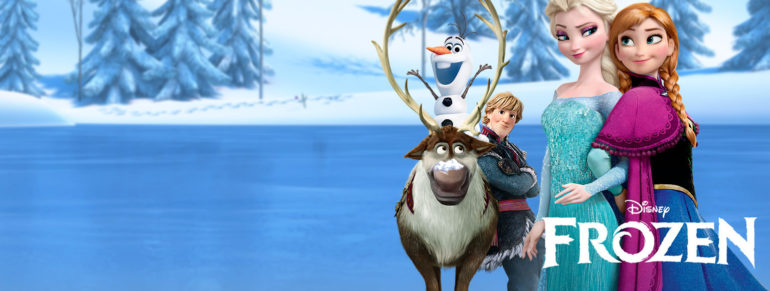Over the last 75 years Walt Disney Animation Studios have become pseudonymous with big, warm, song-filled, colourful and joyous animated films, that have have become perennial favourites and that helped as establish the House of Mouse as a dominant player in the entertainment industry. This dominance, particularly in the world of animation, was borne on the back of two “Golden Ages”. The first, from 1937 to 1942, brought us Snow White and the Seven Dwarfs, Pinocchio, Fantasia, Dumbo, and Bambi, whilst the second, from 1989 – 1994, featured The Little Mermaid, Beauty and the Beast, Aladdin, and The Lion King. It is against all the films, and other classics scattered in between, that any new Disney Animation feature is measured. And that’s a lot of pressure on any film-maker’s shoulders. During Walt Disney’s time in charge of the studio fairy-tales were the constant source of inspiration for the animators, and it is to this well that Disney has returned for its latest endeavour, Frozen, based on the Hans Christian Anderson story The Snow Queen. With the current run including the vastly under-appreciated The Princess and The Frog, the incredibly fun Tangled, and the brilliant Wreck-It Ralph can Frozen continue the current rich vein of form, and maybe, just maybe, start the third “Golden Age”?”
In the Kingdom of Arendelle lived a benevolent and much loved king and queen, who had two beautiful daughters. The eldest of these, Elsa, was born with a gift, an ability to create ice and snow. One night while playing with her younger sister, Anna, she accidentally freezes her sister forcing her parents to lock her away for her own and everybody else’s good. Wiped of her memory of the accident Anna grows up alone, believing that her sister, who never leaves her room, wants nothing to do with her. When the king and queen are unexpectedly killed, Elsa must assume the throne and open up the castle gates for the occasion. Buoyed by the experience of getting out of the castle Anna confronts her sister, causing Elsa to lose control of her powers and plunge the kingdom into endless winter. Unable to cope Elsa flees, and it is up to Anna, along with some help from a reluctant ice salesman Kristoff, his pet reindeer Sven, and a talking snowman Olaf, to seek out Elsa and hopefully end the winter.
What truly separates classic Disney from all other animation studios is Disney’s understanding and appreciation that the voice must fit the character and not the other way around. By casting Broadway stars Idina Menzel and Jonathan Groff as Elsa and Kristoff respectively they allow for the transition of speech to song to be natural and wondrous. Menzel in particular is a revelation as Elsa, with her central song Let It Go matching the extraordinarily impressive visuals to create easily the best animated sequence in years, possibly since the Sorcerer’s Apprentice scene in 1940’s Fantasia. She’s equally at home in the non-singing sections, building a convincing rapport with Kristen Bell’s Anna. Both women lost out in the race to be Tangled‘s Rapunzel to Mandy Moore, but both can be equally sure that their performances here are more than a match for hers. Bell embeds a fierce determination and will into Anna, filling her character with life and vibrancy. Groff’s Kristoff is underwritten, and has more than a little Flynn Rider in him, but it is still a strong performance and his relationship with Anna is believable. The comic relief of Josh Gad’s Olaf and the non-speaking Sven does not overwhelm or undermine the film, and that’s a delicate balancing act to pull off. Gad has some great comic moments, with his song being a particular highlight of wit. Elsewhere Alan Tudyk offers another great villain to his collection as the Duke of Weaselton, with Santino Fontana’s Prince Hans an interesting twist on the classic Disney Prince, and Chris Williams hilarious as Oaken, owner of Wandering Oaken’s Trading Post and Sauna.
To make a truly memorable Disney animated film you need three key ingredients; a good story, great visuals, and memorable songs. Frozen scores big on all three. The central relationship of Elsa and Anna is very well defined. The pacing is spot on as the film is never rushed nor feels dragged out. The love stories are different and interesting for that, and there’s a very strong spirit of self-reliance and self-confidence that has become a hallmark of recent Disney princesses. Here they do not fall into the old trap of the guy being the solution, so that is very welcome. Oh and then there’s the music… Let It Go is the stand-out, and should win the Oscar for Best Original Song at a canter, but the other numbers are of equal merit and this is a soundtrack that you will want to own. Credit to husband-and- wife duo Robert Lopez and Kristen Anderson-Lopez, and composer Christophe Beck for their work here. With music this sublime it would be easy for the animators to sit back and let the songs do the heavy lifting, but instead they upped their game and created a spectacular looking film. Again the Let It Go sequence is the highlight, with the use of colour, fractal shapes and sweeping movement making perfect use of the computer animation and 3D. That’s not to say that the budget is blown on that sequence as throughout the snow and ice effects are astonishingly good, and the Kingdom of Arendelle becomes a place that you would happily spend a winter.
If you couldn’t tell from the above I adored this film and I encourage kids and adults alike to go and delight in its escapist pleasures. With Frozen, Walt Disney Animation Studios have made a truly modern, fresh and vibrant, classic Disney family film.

